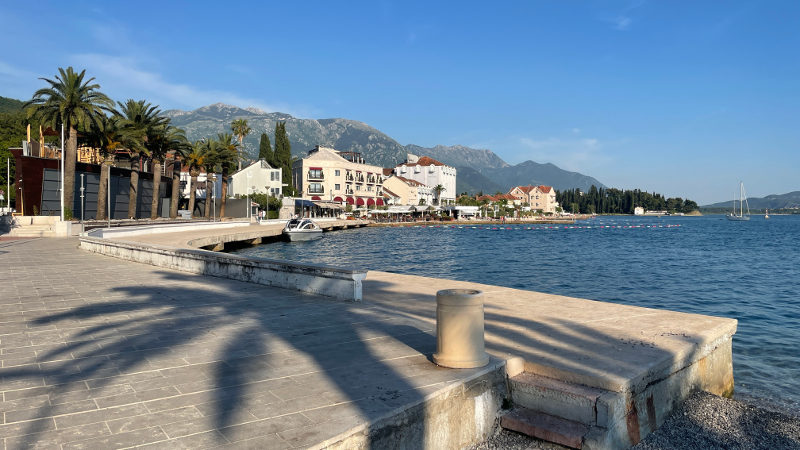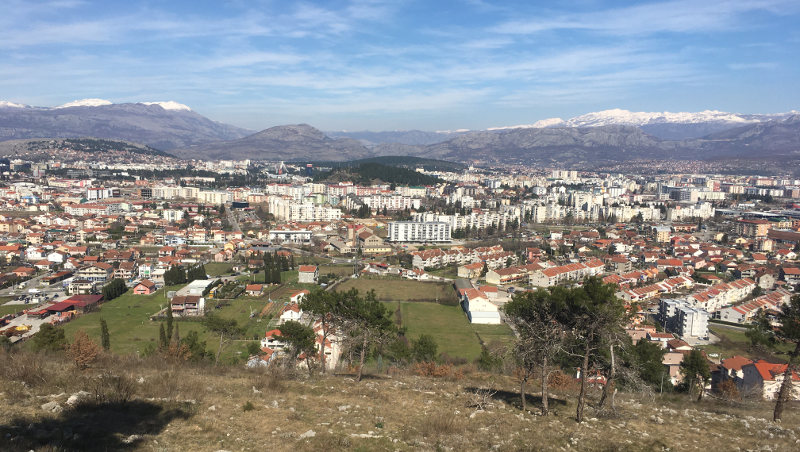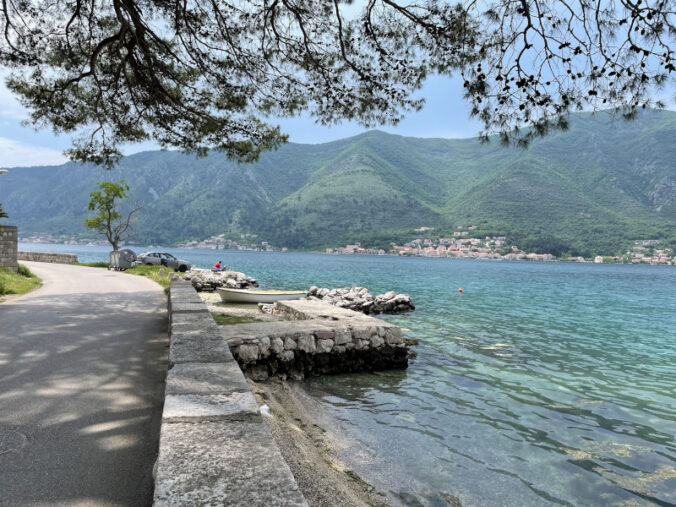Montengro is a tiny country but has a diverse range of places to live. The coast is usually the first choice for the newcomer to Montenegro for the sun and the sea – but there are many other options, from the capital to the mountains in the north.
The Coast
Montenegro is best known for its coast along the Adriatic, a summer mecca.

Tivat
Tivat is a small town on the outer part of Boka bay, ten minutes from Kotor. It’s centre is Porto Montenegro, the billionaire’s marina and restaurant complex. The town is popular with expats because it gets plenty of sun all year, and with families as it has several international schools.
There are plenty of foreigners in Tivat. You’ll hear more English spoken here than anywhere else in the country. This means it’s easier to get by with English, plus there are more restaurant options than the usual Italian or Montenegrin (there’s an Asian restaurant!). There are also usually more expat and nomad meetups here than anywhere else.
In the winter you’ll see the same people five times a day (an advantage or disadvantage as you see it), while in summer it fills up with nomads and tourists.
Herceg Novi
Herceg Novi has a lot of passionate expat fans: for its small but tight-knit expat community, lots of sun in the winter, 7km long promenade along the coast, mountains right behind the town, and its cute and working old town.
It’s also right near the border with Croatia and not far from Dubrovnik airport, which means better access to the rest of the world through the bigger flight schedule, and to shops not available in Montenegro like Ikea and Lidl.
Disadvantages are mainly the inaccessibility from the rest of Montenegro. To get to Tivat and Kotor you need to take a ferry (five euros for a car) or drive the entire interior border of Boka Bay (about a forty-five minute drive). Podgorica is two hours away.
The northern mountain town of Žabljak is accessible by car via the Nikšič-Risan back road in a two and a half hours, but you won’t be making day trips to go skiing in Kolašin as it and the rest of the north is almost four hours away.
Kotor
Kotor is the natural first choice to live in for the newcomer to Montenegro, as the combination of old town, fortress, bay and mountains are utterly charming – who wouldn’t want to live there?
Sadly, it’s one of the most expensive places to live in Montenegro and it has two significant downsides: tourists in summer, and terrible weather in winter.
In summer, when cruise ships are running and offloading a couple of thousand people at once, it’s almost impossible to walk around the old town. Even without cruise ships, summer traffic can get crazy as there is only one road around Kotor. It can take an hour to go a few hundred metres.
Winter is the complete opposite. Tourists desert the place and the only inhabitants are the 15,000 locals and students who attend the local university. And, due to the angle of the mountains, it gets only a few hours of sun a day.
It also gets more rain than almost anywhere else in Montenegro. I thought I about living in Kotor after my summer there – but my local friends said it was like a horror movie in the winter.
If you really want to live near Kotor year-round, go a little further up the edge of the bay to Dobrota or Sveti Stasije. You’ll only be a few minutes drive from the old town, but apartments here get a lot more sun and there is a nice promenade along the coast, plus a few restaurants, supermarkets and shops.
Budva
Budva is home to many Russian-speaking expats, but not so many English-speakers. It has a small but beautiful old town, and some lovely beaches all the way from Mogren to Sveti Stefan, but outside of the actual coastline it is wildly overbuilt with ugly apartment blocks.
It becomes an international party town and is crammed with tourists in the summer. In the winter it has the advantage of not becoming quite as much of a ghost town as other coastal towns – some restaurants and cafes stay open all year.
Bar
Bar is usually forgotten on lists of where to live in Montenegro, not having many English-speaking expats. However, it does have the advantage of being cheaper coastal living and a year-round city.
Bar is like a compact Podgorica on the coast, plus a small marina, a promenade along the edge of the water, and the wonderful Stari Bar old town and its restaurants a few minutes drive up the hill. It’s also on the train line which goes to Podgorica, Kolašin and all the way to Belgrade.
Ulcinj
Ulcinj is a summer tourist town in the far south of the coast of Montenegro. It has a different feel to the rest of the coast, as it is majority-Albanian (it’s right next to the border). It’s low cost and has a ton of different beaches and natural attractions, but everything is spread out enough that you would need a car to get around.
Podgorica & Surrounds
The capital is in the central and flattest part of the country, next to Lake Skadar.

Podgorica
The capital is the administrative, shopping, and population centre of the country, with around 200,000 people. It has the highest number of expats, but they are diplomats, NGO workers, consultants and the like, rather than remote workers or foreigners who moved here for the sun or the cheap cost of living.
Podgorica itself has a reputation as a boring and ugly city but it’s actually very liveable and even attractive once you get to the northern parts of the city. It’s compact and walkable (with cheap taxis when needed), and has a low cost of living. 350-400 euro a month gets you a nice foreigner apartment.
Its other advantages are that it is a year-round city: with malls, gyms, yoga studios, dance studios, restaurants, bars and cafes that work all year round; and accessibility. Podgorica is central in the country and well-connected to everywhere by bus, road and train. Kolašin’s ski centres are a little over an hour away, the coast is 45 minutes away, Lake Skadar is half an hour away.
It’s also the opposite of the coastal towns in that it is full in the winter and empties out in the summer, on holidays, and on Sundays. Most locals have weekend houses, family village houses, or coastal apartments that they escape to on non-working days.
The main disadvantage in Podgorica is summer. Podgorica is in a basin that acts like an oven and temperatures can reach 40C and stay there for weeks. On hot days the town completely empties of people; everyone leaves town or hides in their air conditioned apartments.
For more info on Podgorica, read What to Know Before Coming to Podgorica and How to Rent an Apartment in Podgorica.
Around Podgorica
There are few smaller towns and dozens of small villages around Podgorica in ten to thirty minutes drive, which are considered incredibly distant by locals but really not that far if you’re from a bigger country. If you have a car, it’s definitely an option to live near Podgorica in a smaller and quieter place and just drive in for the supermarket and errands.
Cetinje is the biggest, a town of 17,000 people up in the mountains thirty minutes from Podgorica. It’s the old royal capital and cultural centre, and is a nice-looking town with some good museums and attractive old buildings.
It’s not far away from Podgorica but has quite different weather: snow in winter and five degrees cooler in summer. It has terrible air quality in winter, as locals mostly use wood stoves and the smog just sits over the town. It’s popular in summer for cooler weather and cheap restaurants.
The North
The north of Montenegro is mountainous and gorgeous, with jaw-dropping scenery, ski centres, national parks, and a mix of tourist towns and traditional life.

Nikšič
Nikšič is a central town of 60,000 people. I’ve never met an expat who lives there, but I’m told the people are friendly and prices are lower than Podgorica. It’s also only 45 minutes from the capital and connected by both bus and train.
Kolašin
Kolašin is a mountain town of about 3,000 people where the main ski centres are located. It’s a pretty tiny town with one main street, but is a hiking and nature centre in the summer and ski town in the winter. It’d make a decent base for the winter if you are a keen skier but accommodation could be hard to come by when everything is full in the peak ski season (January and February).
Žabljak
Žabljak is way up in the north, right next to Durmitor national park. It’s a very small town of around 1,500 people that expands to ten times that in the summer with tourists and locals hiking and escaping the heat. It’s extremely beautiful but the climate is cold: even in a heatwave daytime temperatures rarely get to 25C and winter nights can get as low as -15C!
.
I hope that helps with your decision of where to live in Montenegro! If you’re serious about living here, I’d recommend spending some time in a few of these towns to see which one you click with.


Hi Kate love your post I visited Croatia, the Sea Organ in 2015 with my granddaughter and daughter then Montenegro, October 2018 and I was fortunate to meet relatives
My Mother’s great great grandfathers are from Yugoslavia now known as Croatia and Montenegro, beautiful areas
In Montenegro I visited Ostrog in what town is the wonderful place located
Hi Wanda! Ostrog is high up on the mountain side parallel to the road between Podgorica and Nikšić.
Hi, I read your post, thanks for tall the descriptions of the areas. I am looking to do some digital nomad/semi retiring in Montenegro. I would like to get a water view flat and an ebike and use that to get around and also explore all the trails and coastline. Working from home on my computer, it can be hard to make friends and I would be single with a couple cats. Not a drinker anymore so partying is not relevant. Do you have any recommendations regarding Budva, Seoca and other areas as to what would be more suitable for the 48 yo American relocating there to integrate, make friends and not be a shut in? I also like the idea of easy access to other european countries for short vacations to mix it up.
Hello Kate!
I am so grateful for your blog and all the great info you have posted! Thank you, thank you!
I will be in Montenegro from the end of July to the end of October this year – for my very first time.
You mentioned your interest in permaculture – which I share and have trained in as well. Do you have any leads for a permaculture farm that may offer accommodation and may accept/want some volunteer work in the garden or for harvesting?
Also, I would love to be around a meditation group or more spiritually inclined people. Any ideas where that can be found?
Much gratitude and blessings!
Hi Gabriele, check Workaway.com for volunteer stays in Montenegro. I know some local farms that have listings there. For spiritual groups try Pachamama.
Hi Kate, Great article and website. I’m also an Aussie, currently living in Greece, and interested in Montenegro. Like you, I’m interested in permaculture and would like to live with acreage. What area would you recommend looking for good farming land, but not too isolated, with decent weather? Doesn’t need to be near sea. Thank you!!
Hi Bec, for good farmland I’d recommend Zeta near Podgorica, or the valley that runs from Podgorica to Nikšic through Danilovgrad. Nothing in these areas is too far from a town, and while it can get pretty hot in summer it doesn’t snow in the winter. Good luck with the search!
Hi Josh, a visitor chiming in here. I suggest you look at Budva (have not been to Bar). There are both new apartments and renovated ones in Tivat, same in Budva. But there is more to do in Budva if you’re on your own; Tivat is pretty sleepy. Just this morning I saw people jogging in the park and congregating around a gym close to the water, which has an outdoor workout area too. Cafes abound and people sit and talk a long time. Kotor is not e-bike friendly as it only has one main street and it is tiny, shared with parked cars and buses. It’s even hard to be a pedestrian there. Good luck!